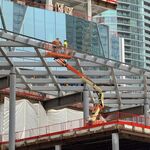TransitBart
Senior Member
There is a monkey-wrench in having a second airport in a city which I think this discussion is missing.
It's a colossal pain in the ass.
Cities with a second large commercial airport have one because the existing large airport can not handle more capacity. There is no place in the world running (joyfully and efficiently) a second or third large airport.
1. Airlines find it a pain in the ass to fly into more than one airport. Check rbt's post about Air Canada flying to JFK.
2. Airports end up serving different audiences. JFK (in NYC) serves international traffic because it has runways long enough for jumbo jets. Laguardia (NYC) serves domestic traffic only because it has short runways - an old and tired terminal building and is closer to Manhattan. If you were flying to NYC for a day and had to travel through JFK, you'd spend more time travelling from JFK to Manhattan than you would from YYZ to JFK. Newark serves a different audience because NYC is so hard to travel around and the other airports lack capacity.
3. It's a pain in the ass for travelers. If you book a flight from NYC to somewhere that you can't fly from Toronto - admittedly very few places - like Johannesburg, then you'd need to get to JFK. But from YYZ, you can only fly to Laguardia which leaves you taxiing, training or bussing miles between airports, let alone terminals.
4. Cities with more than one airport typically have a 'premier' airport and then a collection of also-rans. Think of Heathrow vs Gatwick and Stanstead. One is a vacation airline airport and Ryanair - the ultra-low-cost-flyer - flies to both Gatwick and Stanstead. No business traveller would touch either. As for Paris, we all probably remember Charles de Gaulle, but how many remember the former airport Orly. It's a major European hub for Paris, but clearly a secondary airport to CDG. Also a pain in the ass if you are flying from a secondary airport elsewhere to get to CDG for the international flight back to North America.
It is worth preserving Pearson at almost any cost. An airport in Pickering would cripple Toronto as a business centre. YYZ is still a 20 minute train ride and under some circumstances a 20 minute drive from downtown. At best, the Pickering lands are a 60 minute drive on a highway (DVP) with zero additional cpacity. The viability of Toronto as a business city would plummet instantly with a a second airport (vis-a-vis YYZ) or a primary airport in this location.
It's a colossal pain in the ass.
Cities with a second large commercial airport have one because the existing large airport can not handle more capacity. There is no place in the world running (joyfully and efficiently) a second or third large airport.
1. Airlines find it a pain in the ass to fly into more than one airport. Check rbt's post about Air Canada flying to JFK.
2. Airports end up serving different audiences. JFK (in NYC) serves international traffic because it has runways long enough for jumbo jets. Laguardia (NYC) serves domestic traffic only because it has short runways - an old and tired terminal building and is closer to Manhattan. If you were flying to NYC for a day and had to travel through JFK, you'd spend more time travelling from JFK to Manhattan than you would from YYZ to JFK. Newark serves a different audience because NYC is so hard to travel around and the other airports lack capacity.
3. It's a pain in the ass for travelers. If you book a flight from NYC to somewhere that you can't fly from Toronto - admittedly very few places - like Johannesburg, then you'd need to get to JFK. But from YYZ, you can only fly to Laguardia which leaves you taxiing, training or bussing miles between airports, let alone terminals.
4. Cities with more than one airport typically have a 'premier' airport and then a collection of also-rans. Think of Heathrow vs Gatwick and Stanstead. One is a vacation airline airport and Ryanair - the ultra-low-cost-flyer - flies to both Gatwick and Stanstead. No business traveller would touch either. As for Paris, we all probably remember Charles de Gaulle, but how many remember the former airport Orly. It's a major European hub for Paris, but clearly a secondary airport to CDG. Also a pain in the ass if you are flying from a secondary airport elsewhere to get to CDG for the international flight back to North America.
It is worth preserving Pearson at almost any cost. An airport in Pickering would cripple Toronto as a business centre. YYZ is still a 20 minute train ride and under some circumstances a 20 minute drive from downtown. At best, the Pickering lands are a 60 minute drive on a highway (DVP) with zero additional cpacity. The viability of Toronto as a business city would plummet instantly with a a second airport (vis-a-vis YYZ) or a primary airport in this location.
Last edited:




